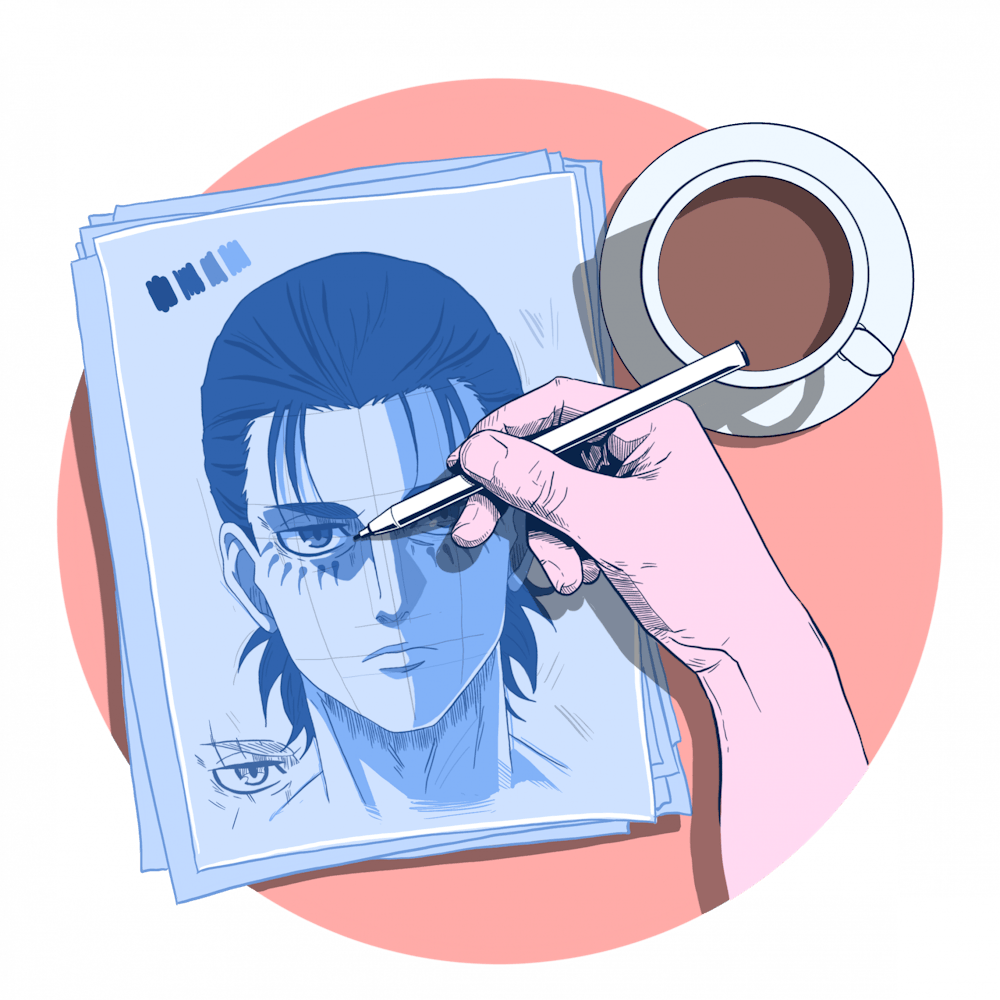If you’re not an avid anime watcher, you would most likely be dissatisfied with a 20–minute episode for a drama series. However, when taking into account that mainstream anime is almost entirely hand–drawn and consists of approximately 3000 frames/drawings per 20–minute episode, with each drawing taking more than an hour to create, one’s perspective may shift ever so slightly. The anime production process is intricate and those familiar with the art form have learned to judge animation quality and recognize the “trade–off between detailed, consistent designs and more fluid animation.”
One particular anime that fans deemed worthy of hype was Attack on Titan (Shingeki no Kyojin), which was adapted from a Japanese manga series by Hajime Isayama. A dystopian action series revolving around the impending destruction of the human race by flesh–eating Titans, Attack on Titan has garnered a lot of support from Western viewers—stealing the crown for the most popular show in the U.S. during the week of Jan. 31–Feb. 6, 2021.
MAPPA, a renowned Japanese animation studio, took over from WIT STUDIO for the final season of Attack on Titan. This move was met with indignant outcries from fans and anti–fans alike, who criticized the increased use of CGI (computer–generated imagery), new soundtracks, and overall animation quality. A despicable group of “fans” launched vitriolic attacks on MAPPA staff via Twitter upon the release of each week’s episode, forcing an anonymous staff member to issue a statement (which they later deleted) regarding the tight production schedule for Attack on Titan.
While it may be instinctive to blame anime studios and animators for mediocre filler episodes and so on, they are actually relatively powerless—it is the production committee that makes the executive decisions about the number of episodes a manga is adapted into, which animes are produced, and the size of the budget for the anime studio. According to a 2016 article, WIT STUDIO had merely 34 employees, explaining their decision to step down after the production committee imposed severe time constraints for Season 4 of Attack on Titan.
The animation industry in Japan generated over $10 billion USD in revenue from overseas sales in 2019 alone. However, anime studios often can’t afford to be on production committees, which hold IP licenses and merchandising and distribution rights—meaning profits from anime productions seldom reach the pockets of anime studios.
What’s more distressing is the disparities in income between key animators (“genga–man”) and in–between animators (“douga–man”). The former is responsible for pivotal frames, whereas the latter is in charge of transition frames and refining the work of key animators. The position of key animator is highly coveted due to the artistic autonomy granted to the individual, whereas in–between animators are frequently disparaged due to the grunt work the position entails.
The average annual income for in–between animators—a position typically reserved for freelancers or entry–level animators—is only $12,000 USD, according to a 2019 report by the Japan Animation Creators Association (JAniCA). This issue has been acknowledged by those directly affected, but anime labor practices have yet to change.
Combined with the fact that MAPPA took on several projects simultaneously—Chainsaw Man, Jujutsu Kaisen, Yasuke, and Dorohedoro, to name a few—it's unsurprising that its animators were severely overworked and underpaid. On May 14, 2021, popular freelance animator Mushiyo tweeted about his decision to leave MAPPA:
いや本当これなんですよ、何のために頑張って会社入ったのか分からなくなったんよな、なんで社員のうちらが外で撒いた海外なのか野良なのか分からん汚ねぇ原画動画を毎週毎週毎週毎週毎週毎週毎週毎週毎週毎週毎週毎週朝まで直さないかんの??って辞めようと思ったきっかけの一つ。
— MUSHIYO (@Mushiyo07)
(Translation: "I don’t know why I worked hard to join the company, I don’t know why some of the employees were sprinkled outside or stray. Work week, after work week, after work week, after work week. Would you like to fix it until morning? ? One of the reasons I decided to quit.")
Another animator compared MAPPA to a factory and spoke up about the terrible working conditions there, such as having to work until dawn in a filthy space. MAPPA was forced to outsource many of its projects in order to meet the tight deadlines they’d set for themselves, indicating a disconnect between their ambitions and the reality of anime production.
Not only do animators have to deal with backlash, which takes an unrelenting toll on their mental health, their physical health is also neglected in favor of increasing productivity. Additionally, entry–level staff don’t receive adequate animation training, which means key animators are tasked with fixing mistakes. In fact, karōshi—"death from overwork"—is a notorious phenomenon among Japanese workers as the industry is lauded to a toxic extent in Japan, and there is an expectation to do overtime. Others pay the price in the form of prolonged periods of fatigue that culminate in hospitalizations.
This begs the question: Why work in the animation industry at all? Becoming an animator is the dream job for "sakuga" fans who consume the media on a regular basis and have a deep appreciation for the drawings in anime. Many strive to make a name for themselves, hoping to be recognized for their talent and share their work with the world, and are willing to endure atrocious working conditions. The low wages and forced overtime are perceived as necessary sacrifices for their artistic endeavors, and it is exactly this mindset that perpetuates the unforgiving work culture in Japan.
For those of us enjoying anime from a safe distance, ignorant of the industry’s exploitative labor practices, it's important to remember that while anime often presents us with idealized interpretations of the world, their production process is less than ideal. Rather than condemning the underpaid and overworked animators, we should hold production committees accountable. As much passion as animators may have for their craft, it's no substitute for financial and mental stability.







